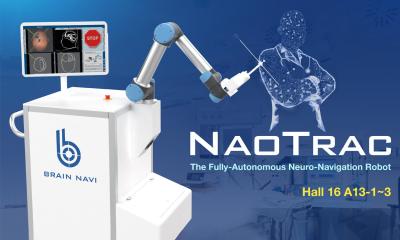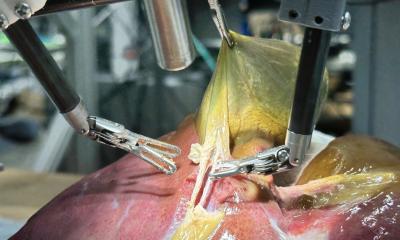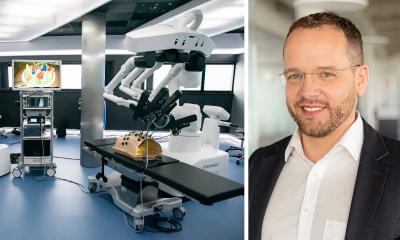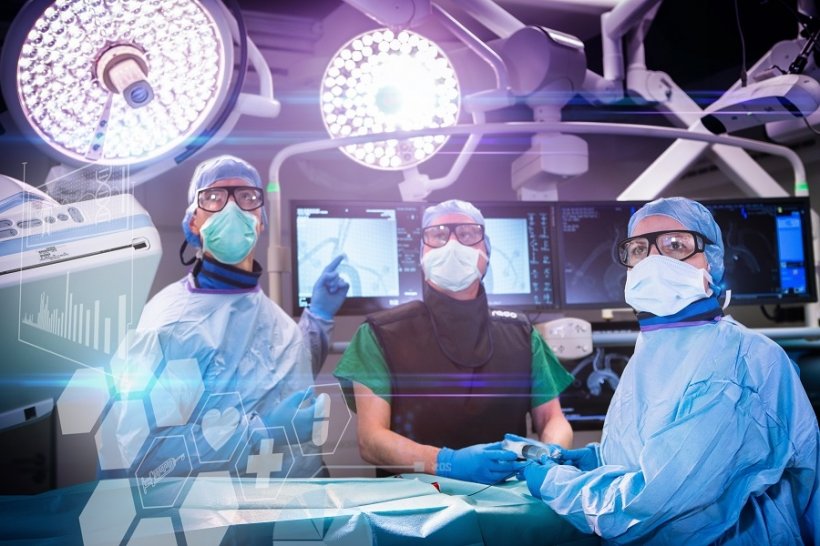
Source: Fraunhofer IPA
Article • Robotic surgery
OR without surgeon: science fiction or realistic scenario?
Dr Jan Stallkamp, Professor for Automation in Healthcare and Biotechnology, has a vision: robots that can treat patients more efficiently and more precisely than any human physician. He estimates that in state-of-the-art hospitals needle probe and catheter-guided interventions can be performed by robots within the next ten years. There is a catch though as, according to Stallkamp, such a development “would need a major upheaval in the research landscape. Medical technology projects with this degree of complexity require better synchronisation of different disciplines. The technology needed to realise such a scenario is not yet available mature.”
Report: Sonja Buske
The same holds true, Professor Stallkamp points out, for disinfection robots whose potential is being explored due to Covid-19: “The idea to have a robot disinfect the hospital presents itself in the current situation. Mobile robots do exist and in a closed space without human beings they can indeed disinfect the space with a spray or UV-C radiation. But what happens when the robot has to negotiate obstacles – e.g. patients – when disinfecting critical details such as door handles, hand rails or telephones?
For mobile robots lifts, automatic doors and staircases have to be built in a certain way so they can handle them. Or the robots themselves have to be constructed so they can overcome hurdles. You very quickly reach the limits of feasibility or financing. The precondition for safe applications is a holistic concept. While current robotics solutions might be able to reduce the infection risk considerably, no cost-benefit analysis is available and indeed such a calculation appears to be difficult.”
For Professor Stallkamp, a mechanical engineer by training, clinical logistics is an area with great potential to decrease operating costs. Whether a tissue sample is taken from the OR to pathology, a blood sample to clinical chemistry or medication to a ward – all these tasks involve a staff member running the errand. Often enough that person receives an emergency call or is waylaid by a patient en route and delays ensue.
“With hundreds of such tasks on a daily basis, transport and the interruptions of the transport are quickly turning into a cost factor. I can image all these tasks being performed by robots in the future. But this also requires a spatial infrastructure that is suitable for robotic applications," says Professor Stallkamp. "And the entire process would have to be automated since often partial automation does not seem to reduce the human or financial resources needed. Moreover, when we are dealing with critical transport tasks such as pain killers or radioactive materials we have to consider all possible scenarios, for example what should happen to the blood sample when a technical failure occurs, when the robot breaks down mid-journey?”
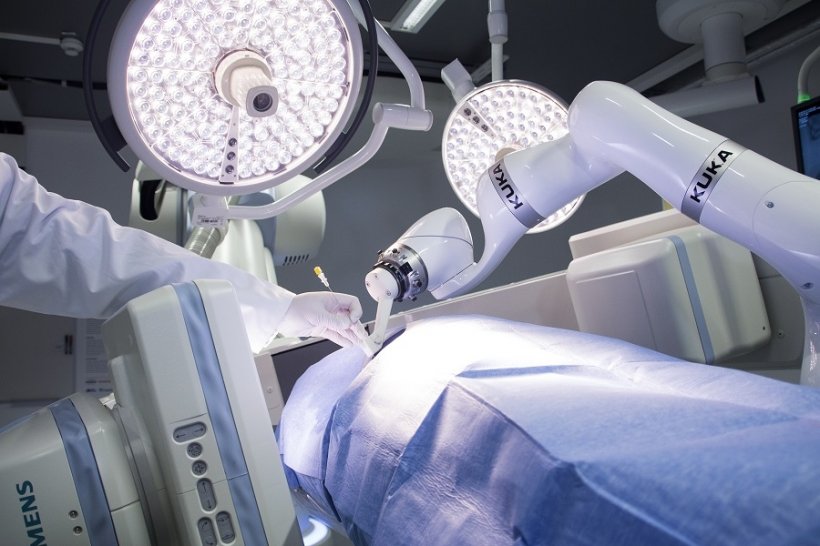
Source: Fraunhofer IPA
Patient transport by robots?
Robots, Professor Stallkamp suggests, might transport not only samples and pills but patients as well: “Today, for safety reasons many bed-ridden patients have to be accompanied by a staff member”, thus simple transport robots are unsuitable since they do not recognize unexpected events such as the sudden deterioration of the patient’s health. However, he says, “it should be possible to develop robots that can recognize these events and take the necessary actions such as calling a physician and taking the patient straight to the right department. Unfortunately, there is a big gap between what’s feasible and what’s possible.”
Professor Stallkamp is well aware of the fact that the hospitals don’t have the financial means do implement such complex solutions. Nevertheless he suggests building each new hospital in a way that robots can be easily accommodated. Technology, he says, is only the smaller problem. It’s the organizational barriers that are more difficult to overcome: “In healthcare it seems that new solutions are only implemented when there is evidence of their practical benefits. The moment we can prove that a robotic system outperforms the conventional approach the hospitals will jump on the bandwagon.”
Overall, the general public is prepared to accept robots and we should build upon this positive attitude. But money remains the linchpin: “Establishing these complex structures requires a lot of money and we have to take more risks. We need teams of financers, industry, clinical users and engineers that have the courage to implement such a project.”
Researchers, he says, have to be integrated in the every-day operations of a hospital and develop structure on the go. A test in the hallway of the research institute won’t do. The robotic technologies, Professor Stallkamp underlines, are not the issue as “there are many good companies and solutions”. However, left to their own devices they can’t fulfil all the requirements a successful clinical robot has to meet. They need interdisciplinary cooperation.
Back to Professor Stallkamp’s vision of a fully automated OR that no longer requires the intervention of a surgeon: “Operations can be performed faster, more precisely, with less stress for the patient and more efficiency for the hospital. But both from a technical and a clinical point of view that’s still a way off.”
The key to this kind of fully automated technology is artificial intelligence which has to replace the one immeasurable factor: the physician’s intuition. “Why does a physician hesitate when performing a biopsy? Why doesn’t she push the needle deeper? That’s expertise and experience, gathered over the years“, says Professor Stallkamp and adds that “we would need a technical solution to measure intuition. If we had that we wouldn’t even need AI anymore.”

Profile:
In 2014, Professor Dr Jan Stallkamp was appointed Professor for Automation in Medicine and Biotechnology at the University Medical Center Mannheim which is part of the University of Heidelberg. After completing his mechanical engineering studies at the Rheinisch-Westfälische Technische Hochschule RWTH Aachen he joined the Fraunhofer Institute for Manufacturing Engineering and Automation (IPA) in Stuttgart as post-graduate.
In 2005, he received his doctorate in medical technology at the University of Stuttgart. At Fraunhofer IPA he headed the Competence Center Medical Technology and later led both the group and the department of Automation in Medicine and LifeSciences. He was co-founder of the Fraunhofer project Automation in Medicine and Biotechnology PAMB in Mannheim which he has been heading since 2011.
17.01.2022



